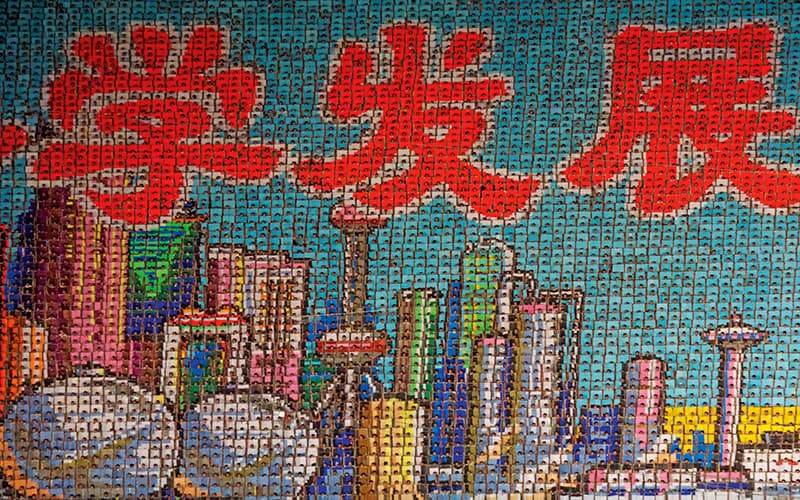Photo Insight with Jeremy Hunter

For the past 30 years, Jeremy Hunter has been dividing his time between TV and journalism. He has taken a special interest in photographing the world’s festivals, rituals, ceremonies and celebrations. ‘Let’s Celebrate 365′ is the result of this life-long interest in these subjects, and an exhibition of his photographs is currently touring Europe
This image, and the set to which it belongs, forms part of a large archive of pictures that I have been working on for most of my career in television and media. I’m creating an extensive body of work called ‘Let’s Celebrate 365′, where I travel around the world documenting festivals, rituals, ceremonies and celebrations. So far, I have around 20,000 images shot in around 70 countries across five continents. It’s an archive that I’m constantly adding to.
So many of the photographs in my archive are taken at rituals and celebrations that are historic. This is particularly relevant because of the political changes that we are seeing throughout the world now, such as the Arab Spring. This makes some regions of the world inaccessible and therefore their rituals may go unseen by outsiders.
North Korea has always been a part of the world I had wanted to visit. The Arirang Festival (or The Grand Mass Gymnastics and Artistic Performance Arirang, to give it its full name) was very high on my list of celebrations to document. The festival, which is a gymnastics and artistic festival known as mass games, began in 2002, and runs from August-September. These displays are historic because Arirang is a celebration in honour of two great leaders of North Korea: Kim Il-Sung ‘The Great Leader’ and Kim Jong-Il ‘The Dear Leader’. As these two leaders are now deceased, we are told that the Arirang displays will not occur again. Kim Jong-Un, the new leader, is an unknown quantity. No one knows if he’s going to continue the tradition.
Arirang takes place in the world’s largest stadium. It seats 150,000 people and is twice the size of the Olympic Stadium in London. Kim Jong-Il, a man who was particularly keen on show business, initiated the event in 2002. He actually started a film industry in North Korea and you may recall hearing in the news that he went so far as to kidnap a very famous South Korean director called Shin Sang-ok and forced him to direct several films with Kim Jong-Il acting as executive producer. Arirang was Kim Jong-Il’s baby. He enjoyed the spectacle of these extravaganzas.
Before travelling to North Korea, I was more than aware of the restrictions on photography there. When you go into North Korea you have to travel via China. When you arrive at Pyongyang Sunan International airport, customs confiscate anything that looks vaguely high-tech or professional. That used to include mobile phones, but we’ve been hearing talk recently of North Korea allowing people to use local SIM cards. The authorities restrict photography to lenses of 150mm, so effectively no more than 3x normal focal length, but there are ways around that. I used something incredibly compact.

Every Arirang mosaic has a story attached to it. The image you see here is of an area of the Chinese city of Shanghai called the Pudong, which is the new industrial region. The Mandarin graphic at the top reads ‘Study and Develop’. There are actually a couple of words missing because I’ve framed it in a particular way. Basically, the message is communicating that the people of North Korea must develop their city as a model of Shanghai: what the Chinese are doing, North Korean people can do in the future. China is very important to North Korea. Historically, China has provided North Korea with financial aid and food. There is a very close relationship between the two countries.
This picture was created by 50,000 teenagers all holding flip charts. The flip charts they use are rather large and they contain more than 150 pages. Each page is one pixel of the overall image. They create these enormous images by using a trapezoidal graph, a 3D image that allows them to work out the perspective. They then use algorithms to find out where each pixel should be in order to create the image.
The children range in age from around 12 to 16 years old. They spend ten hours a day for six months practising, which is around 250 million man-hours of rehearsal. Every breath during the performance is coordinated. The mosaics change every 20secs or so and it happens instantaneously. Then, in the foreground, you have another 100,000 performers who are made up of the military, gymnasts, acrobats and so on.
This mandatory spectacle is put on for what the authorities call ‘the peasant class’ – the people who live in the country. These people are brought in to watch these shows so they can see what their country is capable of.
The mosaics are actually featured in the Guinness World Records book as the biggest living images ever produced. It’s awe-inspiring, but the undercurrent is undoubtedly troubling. No one should visit North Korea with their minds closed to the reality of what they’re witnessing.
These are propagandist displays. In another of my images, one that was taken during the finale, there is a graphic display that reads, ‘Arirang shows how we can work together as one to achieve anything we desire.’ When you take that graphic and apply it to events that took place towards the end of last year, when the North Koreans launched their own long-range rocket, you begin to realise that nothing is impossible to them.
Jeremy Hunter was talking to Oliver Atwell
To see more images by Jeremy visit www.jeremyhunter.com








